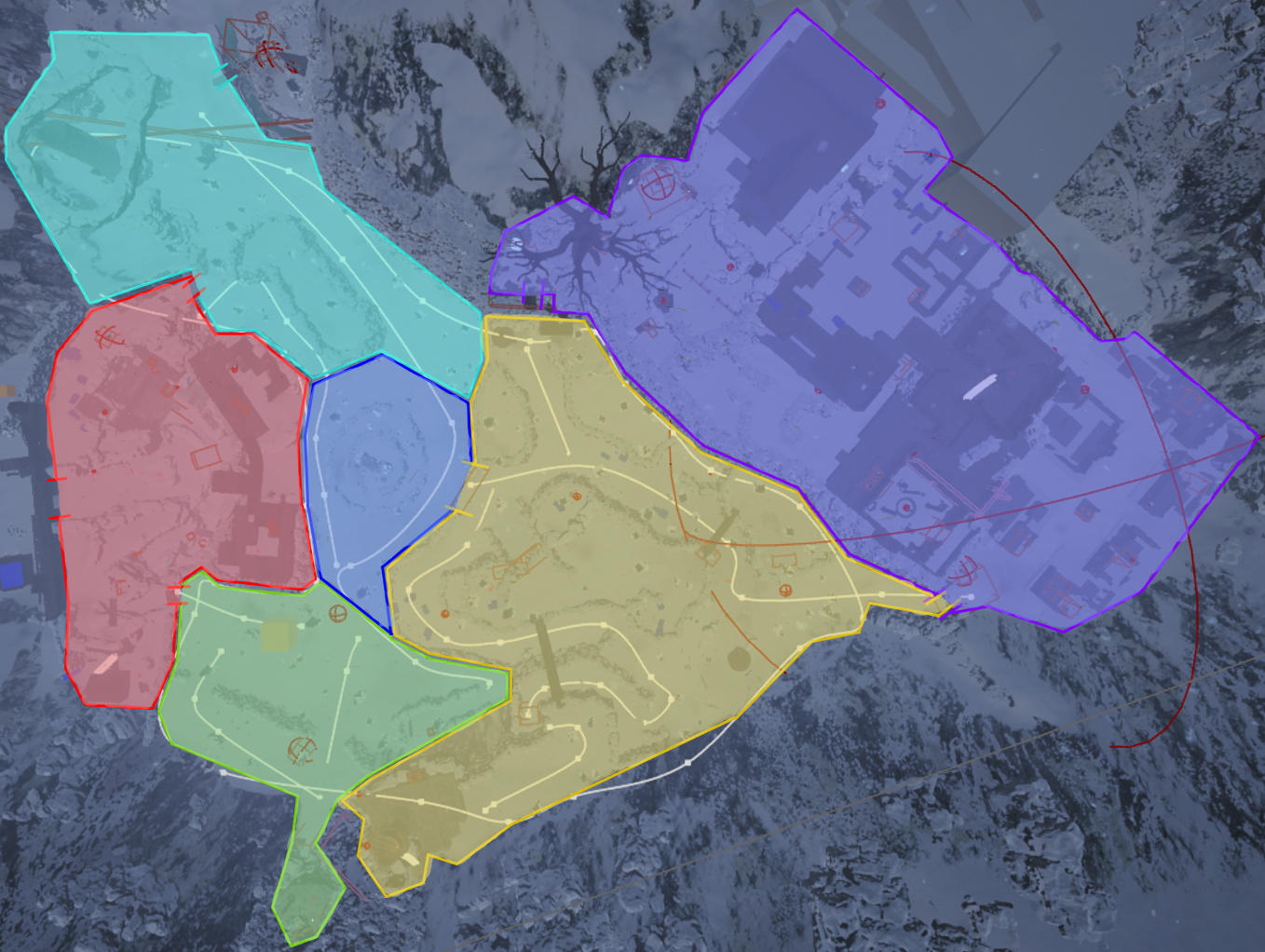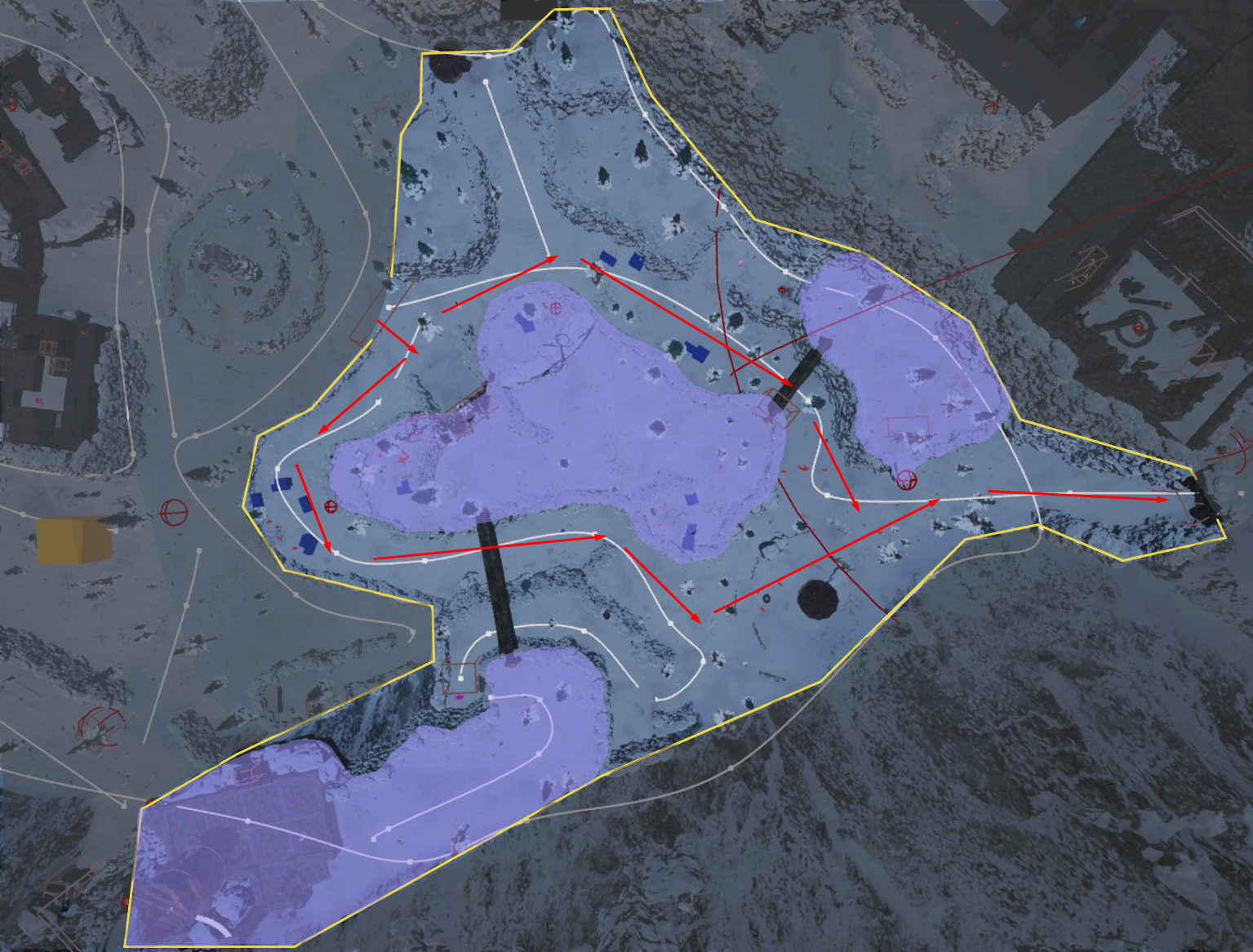KRISTALA (3rd-Person Soulslike RPG)
NOTE: The following content is still under development and not representative of the final result. Many of the assets and layouts are heavily subject to change before full release.
Designing for Open World:
The area primarily assigned to me for Kristala’s newest snowy biome, TANDARA, aims to be Kristala’s first venture into an open world experience for its players. With this new venture, however, comes new design challenges.
The first of these was how to divvy up a large open space in order to keep players engaged while exploring. My solution was to use a centralized structure with Section 1 (see below) acting as both a landmark, as well as the area that players will always be lead back to upon completing any of the surrounding sections. As players have no access to an in-game map, this would aid them in creating their own mental map of the area as well as seamlessly transition the player into exploring the next section that catches their interest without much need to backtrack.
Additionally, I designed the content of each section to be self contained in order to still give the player a sense of open exploration within the specific area but not be overwhelmed by the sheer size of the entire map.
Designing for Playstyle: Kota Valley POI
One of the core principles of Kristala level design is to design areas and encounters that support all of the various playstyles that a player may choose to utilize. In the previous maps, playstyles leaned towards one of 2 categories:
1. The combat approach where players would engage directly with all enemies in their path forward.
2. The stealth approach where players would avoid enemies or sneak behind enemies to perform stealth attacks.
However, in these open world sections, a third approach emerged that needed to be considered and designed around. Let’s use Section 5, the Kota Valley as an example to showcase this. This section is unique in that it not only leads back to the rest of the open world sections, but also directly paths into an important linearly designed area of the map, The Kota Encampment. For many players, reaching this encampment will be the overarching goal of this section.
Below is a view from a lookout point that shows players what awaits them down in the valley.
Combat Route
Hidden Stealth Route
Path to Encampment
Lighting and torches are used here to draw the player’s attention towards the potential routes available to them as well as the main points of interest in the valley. What the player sees is that if they explore to the right of the lookout point, they may find multiple approaches into the valley.
Both the combat route and stealth route provide the player options that encourage their playstyle as they make their way through the valley. However, an interesting dilemma arises when we view the lookout point again - What is stopping the player from simply jumping directly down from the lookout and beelining for the encampment?
Traditionally, in soulslike RPGs (ex: Elden Ring), fall damage and hard deaths after falling an extreme distance act as natural barriers against players skipping entire parts of the map. However, in Kristala, you play as a race of felines who do not take any form of fall damage. Without this barrier at our disposal, how do we stop a player from skipping the entire valley and moving directly into the next area?
Bruteforce approach
The most obvious solution would be to introduce blocking volumes (invisible walls) at the lookout point, preventing players from jumping down at all. However, there has been no precedent in the game so far for players to expect a direct invisible wall and this would only serve to limit the open world experience and disappoint the players.
Instead, I chose to allow players to jump down but incentivize them to find other routes. We implemented a system where if players were to jump down and take the direct path up to the encampment, they will alert the majority of enemies in the area as well as trigger hidden assassin-type enemies. By overwhelming the player with seemingly impossible odds, a player who can pick up on design language would conclude that there must be another intended route that takes them to the encampment, turning this apparent design flaw of the area into a feature.
Of course, while this onslaught of enemies is challenging, it is not entirely impossible to overcome. A small minority of skilled players or even Speedrunners may choose to tackle this challenge head on to progress quickly and I would be very interested to see how these players approach this obstacle.
Designing for Exploration: Taking Advantage of Perspective
In most games, a majority of players may never see 100% of what the game has to offer and one of the big challenges of level design is creating a desire for players to explore the entire space available to them. In a linear setting, this tends to be more straightforward as players are quite limited in where they can move to next. However, in an open world setting, where players have effectively unlimited options when it comes to how they may move through a space, this becomes a bit more complex.
Let’s take the example of Section 2. What we found in our initial playtests is that players would tend to take one of 2 direct paths from the start of the section to the end, exiting into the Ruined City section after. Because the path to the elevated regions of this section was off to the side and not directly in the player’s view, many would entirely miss these portions of content within this area.
Elevated
Elevated
Elevated
Start
End
One proposed solution to this was to simply make the path to the upper regions clearer to the player but this did not entirely fix the issue as most players did not have enough reason to want to explore this side path instead of proceeding to the doorway straight ahead.
My solution was to lock progression into the Ruined City behind a sidequest where players would have to search for two halves of a key item in order to gain entry.
If we take a closer look at the last frame, we notice that perspective is utilized in order to gently guide the player.
The two main points of interest in this shot are the purple item on the cliff and the torch-lit tower in the distance. Players are already trained from previous maps to expect purple items to be unique gear pieces or key items and this, coupled with the tower in the background, while not directly telling the player the location of the key item, serve as clues that what they may be looking for can be found in the upper zones of the area.
By implementing this system and taking advantage of player perspective, the dynamic of this section changed completely into that of a scavenger hunt for key item(s) and we found that now almost all playtesters explored a lot more of the space available to them by engaging with the upper regions of the area.
5
6
1
3
4
COMBAT ROUTE
STEALTH ROUTE
2




